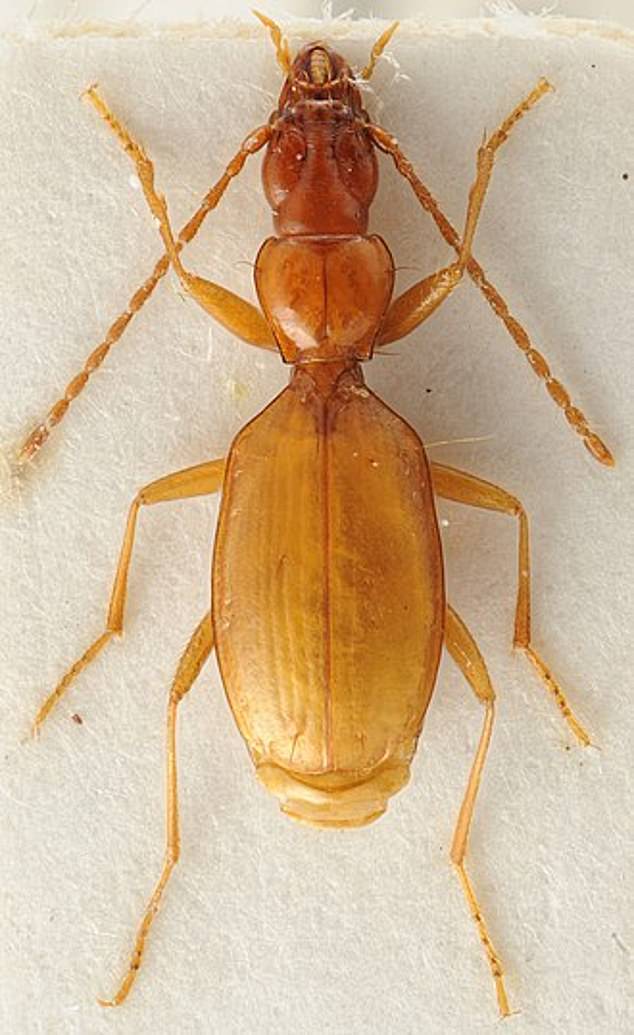A request to change the name of an insect named after Adolf Hitler in 1937 was rejected by zoological experts.
The five-millimeter-long ‘Anophthalmus hitleri’ is a species of blind cave beetle found in just 15 damp caves in Slovenia.
There has long been controversy over his title, and many scientists are horrified that he still shares the name with Hitler, one of history’s greatest monsters.
His name was assigned to him even after the leader’s ruthless racist actions before World War II, including the Night of the Long Knives in 1934 and the Nuremberg Racial Laws of 1935, not to mention the Holocaust that was yet to come.
But after another attempt to change the name, the International Commission on Zoological Nomenclature (ICZN) has determined that it is off the table.
A request to rename Anophthalmus hitleri, an insect named after Adolf Hitler in 1937, has been rejected by zoological experts.
The insect was first discovered in what was then Yugoslavia on June 20, 1932.
It was found by a naturalist named Vladimir Kodric, who stumbled upon the cave called Pekel (Hell in English), one of the beetle’s few homes.
Although the first example is currently behind glass in the Natural History Museum in Basel, Switzerland, Kodric first sent it to an Austrian collector and railway engineer named Oskar Scheibel, according to the New York Times.
Scheibel, believed to be an ardent admirer of Hitler, was convinced that the beetle was a new species, but postponed publishing the news to make sure he was right.
Meanwhile, Austrian-born Hitler had become a German citizen four months before the discovery in 1932.
He was a leader of the Nazi party and was also about to become Chancellor of Germany, which he did in 1933, seizing power in the country.
After his deliberations, in 1937, Scheibel went back on his promise to name the insect Kodric and instead named it after Hitler, calling it Anophthalmus hitleri.
He then notified the Chancellery in Berlin about the insect and its new name, prompting Hitler himself to write a letter of thanks to Scheibel in return.
Unsurprisingly, it’s not the ‘Anophthalmus’ part of the name that people have trouble with. The genus name comes from Greek and literally means “eyeless.”
Some have suggested that Scheibel was actually mocking the dictator by naming a blind beetle after him. However, this is unlikely, as the accompanying description reads: “Given to Reich Chancellor Adolf Hitler as an expression of my admiration.”
Hitler was also known to have a fondness for beetles. In 1933, he commissioned Ferdinand Porsche to design the “people’s car” (Volkswagen in German).
This became the VW Beetle, which still exists today in modern form.

There has long been controversy over the beetle’s title, and many scientists are horrified that it still shares a name with Adolf Hitler (pictured), one of history’s greatest monsters.
Today, Anophthalmus hitleri is in danger of extinction.
This has been attributed to his name and Hitler’s notoriety.
In 2006, the German magazine Der Spiegel reported that almost all of the specimens kept in the Bavarian State Collection of Zoology in Munich had been stolen.
It seemed that the beetle had become a desired trophy for Nazi memorabilia collectors, who are also known for trapping insects in Slovenian caves and selling them for up to $2,000 each.
Martin Baehr, beetle expert at the Bavarian State Collection of Zoology, said in 2006: “These animals are booming and collectors are intruding into the beetles’ natural habitat to get hold of them.”
Slovenia has even been forced to introduce laws against collecting insects to protect endangered species such as Anophthalmus hitleri.
However, it has been questioned whether they are on the verge of extinction and experts wonder how anyone could estimate how many remain in the cave.
However, some suggest that changing the name could help its survival and reduce its popularity among neo-Nazis and collectors of Nazi memorabilia.
The International Code of Zoological Nomenclature discourages scientists from naming species with names that may be considered offensive.

Pictured: A sketch seen in Scheibel’s 1937 article describing the discovery of the beetle.
However, it says it generally does not allow name changes for this reason after they have already been given a scientific name.
Of the beetle, ICZN president Thomas Pape previously said: “It was not offensive when it was proposed, and it may not be offensive in 100 years.”
One solution that has been proposed is to change the vernacular name. Last year the new name Slovenian blind cave beetle was proposed.
However, in its most recent ruling, the ICZN said it would not change the scientific name, saying: “There have been no requests to change the scientific names of animal species for ethical reasons,” according to image.


